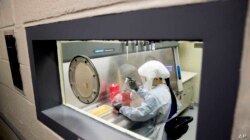Since August, Chinese state media and officials have propagated a wave of disinformation suggesting that the coronavirus behind the COVID-19 pandemic could have been engineered in the United States.
It’s part of a continuing attempt to distract from questions about why the virus was first detected in China, and whether it could have originated naturally there or from Chinese biolabs in Wuhan.
The new push resurrects unsupported innuendo that the novel coronavirus may have originated from the U.S. Army’s biolab in Fort Detrick, Maryland. But it now goes further, casting doubt on the work of a top coronavirus researcher at the University of North Carolina (UNC) at Chapel Hill, North Carolina.
Ralph Baric, a member of the United States’ National Academy of Sciences, has researched coronaviruses for more than 30 years. According to his UNC profile page, some of Baric’s research has been used to develop new drugs to treat deadly coronavirus infections like COVID-19.
Over the years, the profile says, Baric “has warned that the emerging coronaviruses represent a significant and ongoing global health threat, particularly because they can jump, without warning, from animals into the human population, and they tend to spread rapidly.”
But now, the question of whether a jump like that happened with SARS-CoV-2, the virus that causes COVID-19, has become highly politicized. China has tried to shift scrutiny instead to Chapel Hill.
“An investigation into Baric's team and lab is all it takes to clarify whether coronavirus research can create or has created novel coronavirus,” Chinese Foreign Ministry spokesman Wang Wenbin said on August 23.
That statement and its misleading implications previewed a formal request last month by China’s permanent representative to the United Nations, Ambassador Chen Xu, for the world body to investigate Baric’s lab.
Neither Baric nor his lab nor UNC responded to VOA’s inquiries for this fact check. Baric has emphatically denied that his lab engineered “superviruses” or SARS-CoV-2 in so-called “gain-of-function” experiments – research that can make pathogens more virulent or transmissible as a means to study ways to effectively contain them and treat disease.
But in 2015, he and other scientists published a study in the journal Nature Medicine describing the use of “reverse genetics” to create a hybrid coronavirus for testing. The lab-made virus was based in part on a coronavirus collected by the Wuhan Institute of Virology (WIV), a research lab in the city that was the epicenter of the COVID-19 pandemic outbreak in late 2019.
The WIV itself has been at the center of unsubstantiated speculation that a lab accident may have started the pandemic. The lab’s director, Zhengli Shi, and Chinese officials have denied it. However, scientists, including Baric, and the World Health Organization have said a lab origin cannot be ruled out and should be more deeply investigated alongside the theory that it emerged naturally.
After initially stating that a lab origin was “extremely unlikely,” the WHO is pushing China for more transparency about the WIV and other research labs in Wuhan, and for more health data.
In a statement to the Washington Post Fact Checker, Baric said that his lab “has never investigated strategies to create superviruses.” He also clarified both the U.S. National Institute of Health (NIH) and UNC biosafety authority had deemed his 2015 research on the cross-species transmission potential of bat coronaviruses “not to be gain-of-function.”
Critics have said that the NIH employs a definition of gain of function that is narrower than the broader scientific understanding of the term. They argue the NIH guidelines limited the definition of gain of function to pathogenicity (the ability of an organism to produce disease), and virulence (the ability of an organism to cause damage to its host), while excluding host range (the number of species a virus can infect.)
Disagreements over that distinction led to a heated debate between U.S. National Institute of Allergy and Infectious Diseases head Anthony Fauci and Republican U.S. Sen. Rand Paul during a July 20 hearing in Washington.
In any case, Baric said that researchers in Italy and from around the world “have confirmed that none of the bat SARS-like viruses studied at UNC were related to SARS-CoV-2.”
For Baric’s 2015 paper, the WIV’s Shi shared genetic data for SHC014, a new coronavirus Shi and her team discovered in a bat cave. Baric’s team used it to make a mild synthetic coronavirus that demonstrated the potential risks to humans of new bat viral strains.
In an extensive interview with MIT Technology Review, Baric said his lab never sent any of its molecular clones or any manufactured viruses to China, and that while Shi’s lab did similar research to observe risk of coronavirus spillover, it was based on a different bat virus.
Notably, in the 2015 paper, Baric and co-authors did warn of the safety risks of such research, despite its importance as a preventive tool, and listed the layers of safety precautions he had taken.
“The potential to prepare for and mitigate future outbreaks must be weighed against the risk of creating more dangerous pathogens,” he wrote. “Scientific review panels may deem similar studies building chimeric (engineered) viruses based on circulating strains too risky to pursue.”
Chinese media outlets also have highlighted lab safety lapses in Baric’s research lab. Last year, the investigative news site ProPublica reported about six accidents, including a 2016 incident when a lab worker was bitten by a mouse that had been infected with a lab-created coronavirus. The worker did not become ill.
All this is adding fuel for China to sow doubt.
Take the case of Yu Yuan Tan Tian, a “self-media” account affiliated with Chinese state broadcaster CCTV, which recently released a series of videos called “Origin Tracing USA.”
“Self-media” initially referred to independent Chinese social media accounts maintained by individuals producing original content. In recent years, however, almost every major state-backed media outlet and some government branches also have “self-media” accounts.
The latest episode of “Origin Tracing USA” sets out to “reveal the chain of interest” connecting Baric, a U.S. drug company and the U.S. military (i.e., Fort Detrick).
“I wanted to find out the motive of this world's top scientist, then I saw the video shown at the beginning of this episode,” Yu Yuan Tan Tian says in the episode. “I didn't know that all of it was just a business deal.”
The episode then cuts to footage of Baric lecturing at a 2018 symposium, but it places the event and his remarks in a false context. “I wanted to give you good news,” Baric is shown saying. “If you want to make money in the next pandemic, buy stocks in companies that make antiviral drugs.”
In fact, Baric’s presentation was about the risk of a coronavirus pandemic, and the financial advice was clearly a joke aimed at reinforcing the importance of developing treatments in advance.
The purpose of the UNC symposium was to mark the 100th anniversary of the deadly 1918 influenza pandemic. Baric’s remarks addressed the question: “[H]ow bad could the next pandemic be, what might it look like, and will we be ready?” He presented a detailed history of infectious diseases, discussed viruses and other drivers, and reviewed pandemic preparedness and the availability of antiviral drugs and vaccines, including “how much worse it could be” than 1918.
“[T]he vast majority of nations aren’t prepared,” Baric said. “That means the global economy is going to suffer … there is going to be shortages with very little infrastructure, inequities and inequalities in terms of health care … physicians will have to make difficult decisions about who gets care, who lives, and who dies.”
All of these issues are at play in the ongoing pandemic. But according to Yu Yuan Tan Tian, it was about how to “make money in the next pandemic.”
The episode of “Origin Tracing USA” also falsely asserted that Baric received zero funding from the NIH in 2015, following the U.S. government agency’s moratorium on gain-of-function research in late 2014, for fear of viruses “becoming a biological weapon.” The episode falsely said Baric could continue his research and publish the 2015 paper because of support from a “big boss behind the scenes,” described as drug companies and the Army lab at Fort Detrick.
In fact, the NIH continued to support Baric’s research after he made the case that his work with a synthetic virus that is purposefully made less infectious didn’t constitute banned research. According to his MIT interview, the NIH also reached out to Baric in 2018 and 2019 for help developing a vaccine against Middle East Respiratory Syndrome (MERS), another deadly viral respiratory disease.
Contradicting “Origin Tracing USA,” the NIH’s 2014 statement explaining its moratorium on gain-of-function research made no mention of worries about a “biological weapon.”
Rather, Baric said his lab’s work contributed to the development of the mRNA coronavirus vaccines currently being administered, and of Remdesivir, the first COVID-19 treatment approved by the U.S. Food and Drug Administration. A second COVID-19 drug, molnupiravir, is in large-scale trials and has been considered for emergency use authorization in India.
In the MIT interview, Baric said that while a lab leak or accidental infection should be investigated, his personal belief is that the pandemic virus is of natural origin.
“Its closest relatives are bat strains. Historical precedent argues that all other human coronaviruses emerged from animals. No matter how many bat viruses are at the WIV, nature has many, many more,” he said.
“At this time, there’s really no strong and actionable data that argues that the virus was engineered and escaped containment,” Baric added. “As the pathogenesis of SARS-CoV-2 is so complex, the thought that anybody could engineer it is almost ludicrous.”








